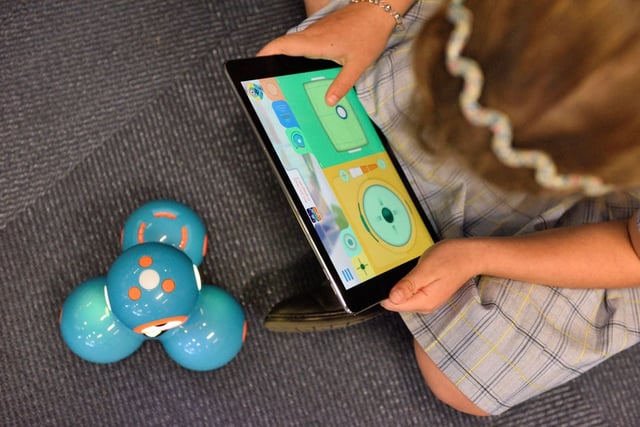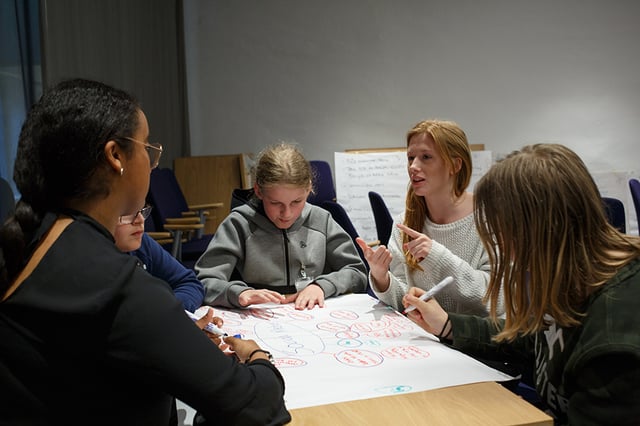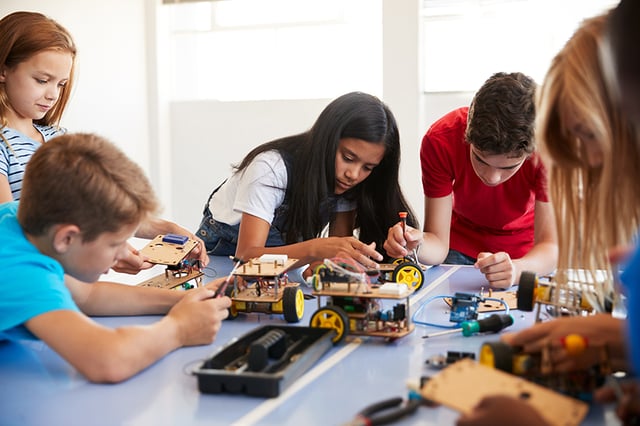Teaching at the Intersection of CTE, STEM, and Career Readiness
 Insights By John Patrick Shell
Insights By John Patrick Shell
I had the strange experience recently when scrolling through LinkedIn and seeing a collection of connection suggestions for some of my former high school classmates. Sure, we’re all still friends on Facebook and probably follow each other on Instagram, but I was struck by the oddity of seeing these people as branded career professionals. It was entirely pragmatic; I mean, that’s why we were all in school, right?
In that moment, I was reminded that the experiences that shaped me also shaped them, the same classes, teachers, extra curriculars, blackboards filled with semi-legible writing, tattered notebooks, and obligatory inspirational posters.
Now working across a wide spectrum of careers, I wonder, how did we all end up where we are? What in those formative years made us ready?
A Career Readiness Lens
This question led me to John Patrick Shell, an engineering teacher in CE Williams Middle School’s career readiness program. In this role, he endeavors to immerse students in real-world learning experiences, impart essential career-ready skills, and “inspire all students entering [his] classroom to become 21st-century ready and aware of all opportunities within STEM.”
Shell is a veteran educator, having spent over 20 years in the classroom. He started as a science teacher for both middle school and high school, specializing in marine science. But through training, Shell became an Engineer and now currently teaches Gateway to Technology (Pre-Engineering).
Under this content area, Shell teaches courses in Automation and Robotics, Design and Modeling, Green Architecture, and Aeronautics. He explains that while “these courses are all very different content wise; they have a consistent theme in developing STEM skills.”
His work is a part of a larger movement amongst educators to reshape education, so learning is highly relevant and ripe with equitable opportunities for students to gain the skills needed for an informed and successful future after graduation.
A career readiness focus expands learning beyond the memorization of chemical compounds or the drilling of complex mathematical formulas and instead empowers students to apply these concepts in the context of real-life scenarios.
Added into the curriculum is also the consideration of ‘soft skills,’ the interpersonal and intrapersonal skills that support entrepreneurship, critical thinking, creativity, and communication as well as new approaches to thought like computational thinking and design thinking.
While there is so much unknown about the future of work, these higher-order thinking skills will be critical to the nature of jobs and workplaces students will face after graduation.
CTE Gets a Rebrand
First, let’s quickly start with a definition of CTE. According to Advance CTE, “Career Technical Education (CTE) provides students of all ages with the academic and technical skills, knowledge, and training necessary to succeed in future careers and to become lifelong learners…CTE prepares these learners for the world of work by introducing them to workplace competencies, and makes academic content accessible to students by providing it in a hands-on context.”
Moreover, CTE engages students in class content through hands-on and real-world projects and enables students to be agents of their learning. This version of CTE differs from its predecessor with elements like “career pathways, industry standards, professional advisory groups, internships, and other work-based learning.”
Today’s CTE seeks to propel students into well-paying, stable jobs while also equipping students with skills to evolve with shifts in the economy; to embrace learning opportunities; and to be problem solvers, creators, and critical thinkers.
Some studied benefits find that when compared to peers not enrolled in CTE courses, students enrolled have:
- Higher high school graduation rates.
- Higher enrollment rates in two-year college.
- Higher wages.
In fact, 67 percent of CTE students cite that enrollment in a program helped them get better grades, 45 percent shared that real-world learning opportunities helps them to better understand their classwork, and 80 percent add that CTE helps them better understand their vocational path.
Career Readiness Meets STEM
To Shell, career readiness is “preparing students to be able to face the new challenges of the 21st Century and beyond!”
Rightfully so, career readiness is vast, but what we can derive is the need for students equipped with technology savviness, critical thinking and analysis skills, adaptability and persistence, and a growth mindset and creativity. There is also a profound need to educate students on topics like STEM and computer science.
Answering this call, much of Shell’s work centers on the convergence of CTE and STEM under the umbrella of career readiness.
When it comes to the evolving job opportunities available to students, STEM careers are by far the most prominent, ranking as some of the fastest growing careers expected between 2016 and 2026. To conceptualize what these STEM careers look like, the Bureau of Labor Services released the following STEM Table, which is aptly modeled after the periodic table.

With the acceleration of STEM careers, it’s natural that career readiness converges with this trend. On this topic, Shell explains: “CTE and STEM go hand in hand…If you look at any CTE job or related skill, STEM concepts and skills are deeply embedded…When students become engaged with CTE, they really see the connection with STEM.”
A District-Wide CTE Program
At Charleston County School District, where Shell works, there is a district-wide career readiness program that shares the vision of “changing the way students learn and choose careers.” This work extends from the district’s recognition of “high-wage, high-skill, and high-demand jobs in [the] region” and “the need to make students fully aware of the opportunities available to them,” adds Shell.
To promote this effort CCSD offers “a wide variety of courses, opportunities, and clubs that motivate, engage and inspire learners to challenge themselves.” In his work building the program, Shell has focused on developing career awareness with students, helping them to understand the opportunities available to them.
Shell aids students in “developing a skillset to succeed in any type of career they choose for themselves.” He often expresses to parents that “the types of jobs their children will do have not been created yet.” Adding, “students will need a variety of combined skills to make them attractive to potential 21st-century employers.”
While many career programs begin in high school or middle school, career readiness at CCSD starts as early as elementary school. In responding to me, Shell describes:
“It is never too early for career exploration. In so many classrooms, the focus is with standardized tests, data, and instruction. Career and Technical Education (CTE) allows elementary learners a way to investigate a variety of careers, understand what types of skills are needed to attain those careers, and gain experience with those careers.”
This integration of career exploration in elementary school allows students to get at the heart of the burning question: when will I ever use this? It helps students understand the ‘why’.
Standards are no longer taught in the isolation of the classroom and are instead rooted in the world outside the classroom and act as a direct extension to a student’s future that persists from grade to grade and school to school, growing with students.
The opportunities to address career readiness and exploration with younger grades abound. A few examples Shell offers include: “creating and attending career fairs at their schools, having older students who mentor elementary students about CTE careers, and hosting CTE professionals in listening sessions for elementary schools to find out what they want to learn about CTE careers.”
A Call to Readiness
Matters of readiness are complex. It’s why politicians debate it, researchers study it, and people like us talk about it, but in classrooms, teachers are bringing it to fruition. They are rewriting the learning experience to ensure it serves students.
In my final question to Shell, I inquired: What does the future of education look like? To him, education is evolving to empower students with “the skillset to adapt to any situation and solve any problem.”
It’s critical thinking. It’s creativity. It’s grit. It’s entrepreneurship. It’s a love of learning.
When I was in science and math classes with my classmates, I mostly saw arbitrary formulas designed to solve problems presented to us by teachers. Little did I realize the ways in which these formulas govern reality, invention, and discovery; and they are deeply intertwined in the work many of my classmates, including myself at times, use in our work and even in our personal lives.
Here, we find this ambiguous idea of readiness.
By changing the narrative of education, making it more accessible and relevant, this shift toward career readiness extends this narrative, imparting knowledge and skills indicative of the world outside the classroom.






